Download Little Dipper Asterism Worksheets
Click the button below to get instant access to these premium worksheets for use in the classroom or at a home.
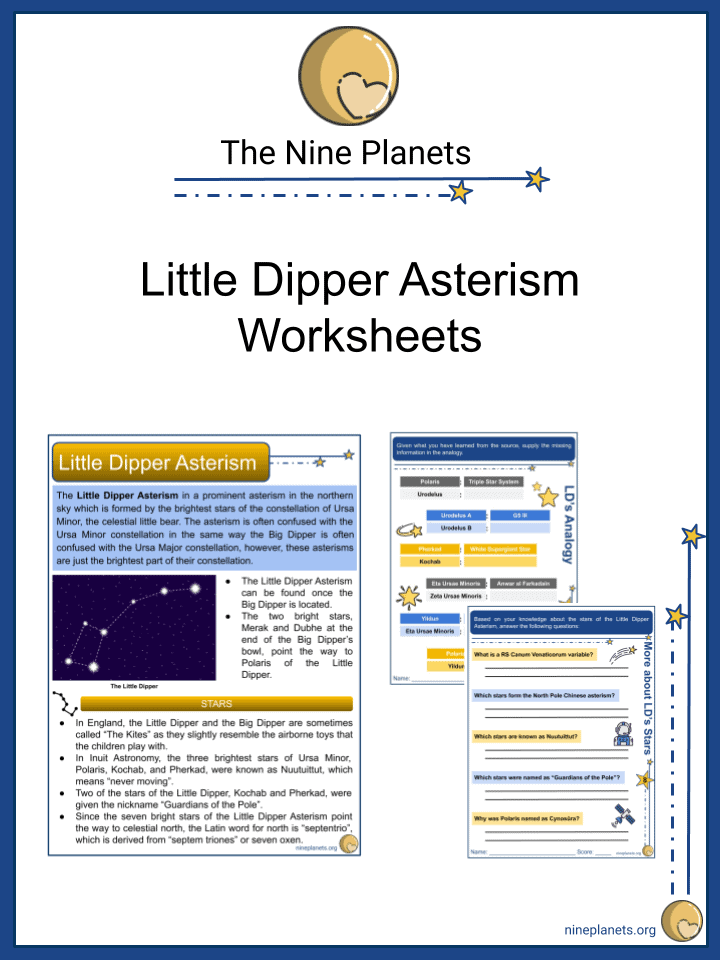
This worksheet can be edited by Premium members using the free Google Slides online software. Click the Edit button above to get started.
Download free sample
Not ready to purchase a subscription yet? Click here to download a FREE sample of this worksheet pack.
Resource Examples
Click any of the example images below to view a larger version.
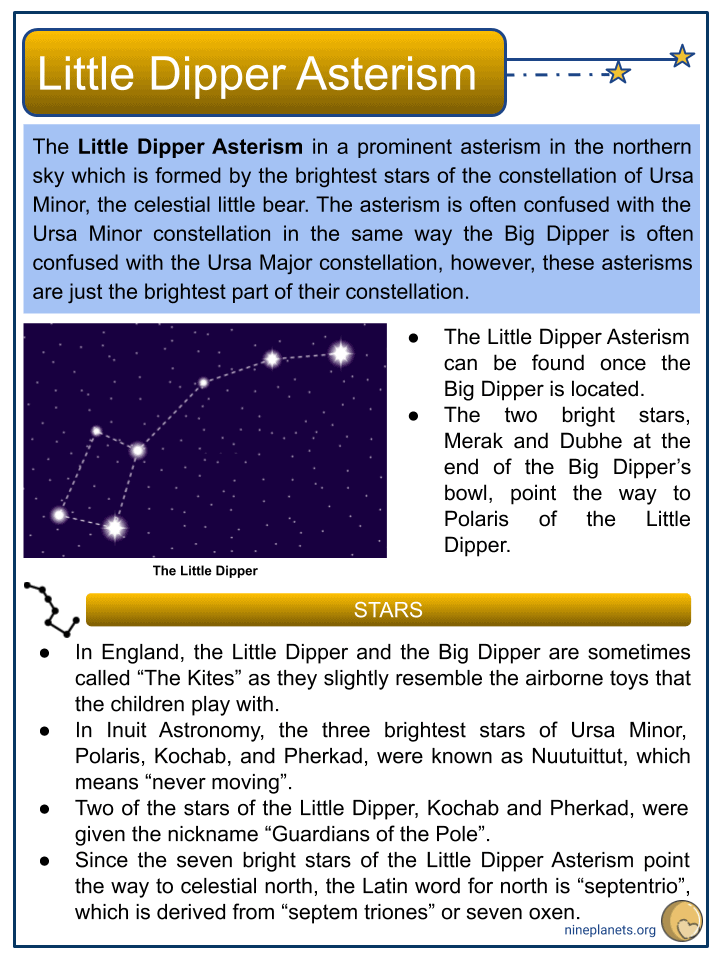
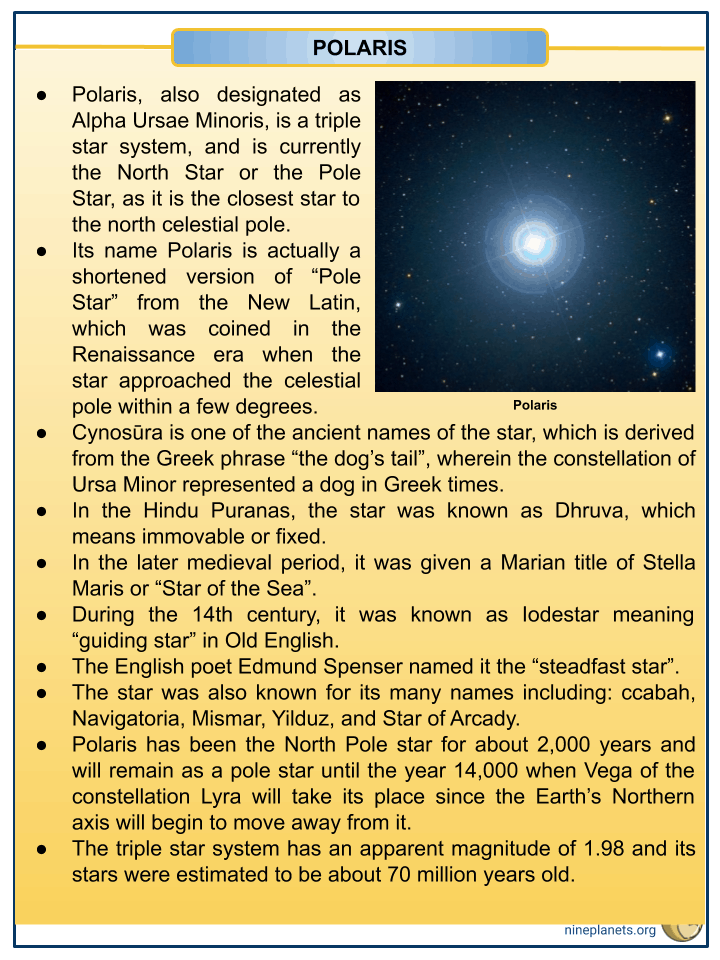
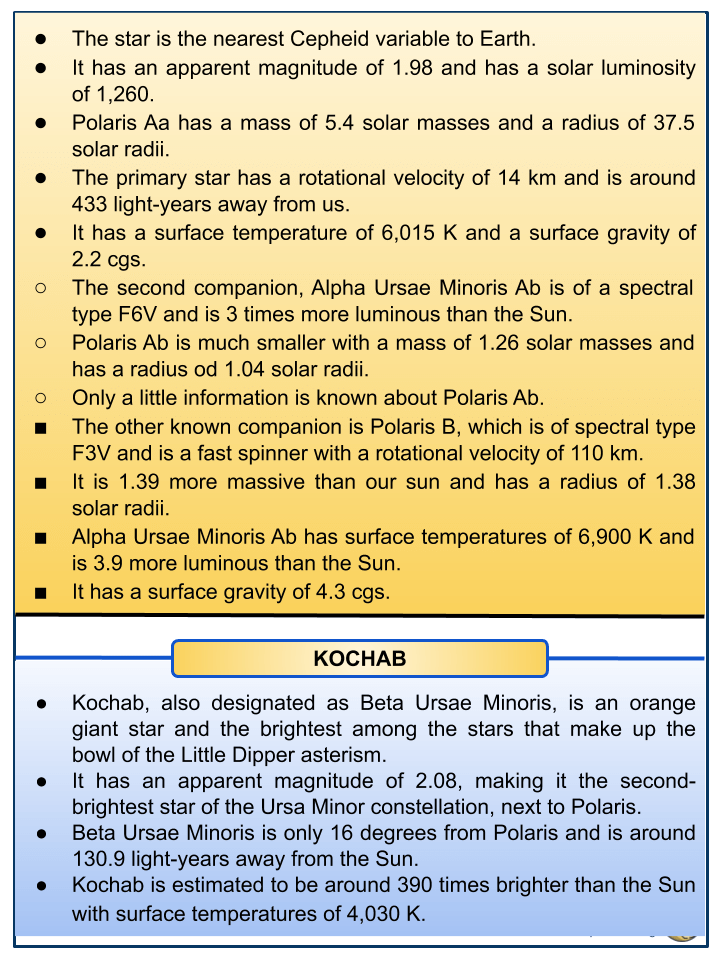
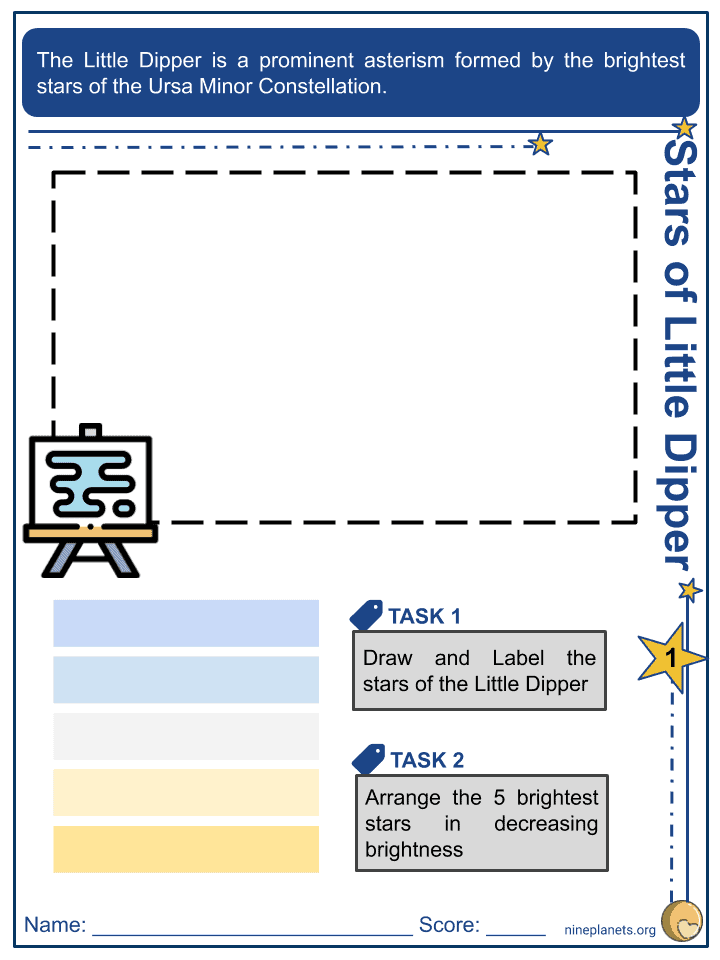
Key Facts & Information
- The Little Dipper Asterism in a prominent asterism in the northern sky which is formed by the brightest stars of the constellation of Ursa Minor, the celestial little bear. The asterism is often confused with the Ursa Minor constellation in the same way the Big Dipper is often confused with the Ursa Major constellation, however, these asterisms are just the brightest part of their constellation.
- The Little Dipper Asterism can be found once the Big Dipper is located.
- The two bright stars, Merak and Dubhe at the end of the Big Dipper’s bowl, point the way to Polaris of the Little Dipper.
Stars
- In England, the Little Dipper and the Big Dipper are sometimes called “The Kites” as they slightly resemble the airborne toys that the children play with.
- In Inuit Astronomy, the three brightest stars of Ursa Minor, Polaris, Kochab, and Pherkad, were known as Nuutuittut, which means “never moving”.
- Two of the stars of the Little Dipper, Kochab and Pherkad, were given the nickname “Guardians of the Pole”.
- Since the seven bright stars of the Little Dipper Asterism point the way to celestial north, the Latin word for north is “septentrio”, which is derived from “septem triones” or seven oxen.
Polaris
- Polaris, also designated as Alpha Ursae Minoris, is a triple star system, and is currently the North Star or the Pole Star, as it is the closest star to the north celestial pole.
- Its name Polaris is actually a shortened version of “Pole Star” from the New Latin, which was coined in the Renaissance era when the star approached the celestial pole within a few degrees.
- Cynosūra is one of the ancient names of the star, which is derived from the Greek phrase “the dog’s tail”, wherein the constellation of Ursa Minor represented a dog in Greek times.
- In the Hindu Puranas, the star was known as Dhruva, which means immovable or fixed.
- In the later medieval period, it was given a Marian title of Stella Maris or “Star of the Sea”.
- During the 14th century, it was known as Iodestar meaning “guiding star” in Old English.
- The English poet Edmund Spenser named it the “steadfast star”.
- The star was also known for its many names including: ccabah, Navigatoria, Mismar, Yilduz, and Star of Arcady.
- Polaris has been the North Pole star for about 2,000 years and will remain as a pole star until the year 14,000 when Vega of the constellation Lyra will take its place since the Earth’s Northern axis will begin to move away from it.
- The triple star system has an apparent magnitude of 1.98 and its stars were estimated to be about 70 million years old.
- The star is the nearest Cepheid variable to Earth.
- It has an apparent magnitude of 1.98 and has a solar luminosity of 1,260.
- Polaris Aa has a mass of 5.4 solar masses and a radius of 37.5 solar radii.
- The primary star has a rotational velocity of 14 km and is around 433 light-years away from us.
- It has a surface temperature of 6,015 K and a surface gravity of 2.2 cgs.
- The second companion, Alpha Ursae Minoris Ab is of a spectral type F6V and is 3 times more luminous than the Sun.
- Polaris Ab is much smaller with a mass of 1.26 solar masses and has a radius od 1.04 solar radii.
- Only a little information is known about Polaris Ab.
- The other known companion is Polaris B, which is of spectral type F3V and is a fast spinner with a rotational velocity of 110 km.
- It is 1.39 more massive than our sun and has a radius of 1.38 solar radii.
- Alpha Ursae Minoris Ab has surface temperatures of 6,900 K and is 3.9 more luminous than the Sun.
- It has a surface gravity of 4.3 cgs.
Kochab
- Kochab, also designated as Beta Ursae Minoris, is an orange giant star and the brightest among the stars that make up the bowl of the Little Dipper asterism.
- It has an apparent magnitude of 2.08, making it the second- brightest star of the Ursa Minor constellation, next to Polaris.
- Beta Ursae Minoris is only 16 degrees from Polaris and is around 130.9 light-years away from the Sun.
- Kochab is estimated to be around 390 times brighter than the Sun with surface temperatures of 4,030 K.
- The star is of spectral type K4 III and has an estimated absolute magnitude of -0.83.
- It has an estimated mass of 2.2 solar masses and an estimated radius of 42.06 solar radii.
- Kochab has a radial velocity of 16.96 km and a rotational velocity of 8 km.
- Its name Kochab appeared in the Renaissance era, but its meaning is still unidentified.
- Some suggest that it might be from Arabic or Hebrew, which is broadly used to describe a celestial body which can be translated to “planet” or “star”.
- In Chinese, it is known as the Second Star of the North Pole, in which North Pole is an asterism consisting of Kochab, Pherkad, 5 Ursae Minoris, 4 Ursae Minoris, and Struve 1694.
- Recently, It was discovered that a planet, which is 6.1 times more massive than Jupiter, orbits Kochab once every 522 days.
Pherkad
- Pherkad, also designated as Gamma Ursae Minoris, is a white supergiant star of spectral type A2 III.
- It has an apparent magnitude of 3.05 and an absolute magnitude of -2.84.
- Kochab and Pherkad form the ends of the pan of the Little Dipper.
- Pherkad is approximately 487 light-years away from the Sun.
- The star is 1,100 times brighter than the Sun with surface temperatures of 8,280 K.
- Its mass is still unknown but it has a radius of 15 solar radii.
- Pherkad has a radial velocity of -3.9 km and a rotational velocity of 180 km.
- It has a surface gravity of 2.53 cgs.
- Gamma Ursae Minoris is also classified as a shell star because it is surrounded by a circumstellar disk of gas that affected its velocity.
- It is also suggested that the disk might be the reason for the variation in brightness of the star.
- Its traditional name Pherkad was derived from the Arabic word “farqad” meaning “calf”, which is actually short for a phrase meaning “the dimmer one of the two calves”.
- In Chinese, the star is known as the First Star of the North Pole, succeeded by Kochab, representing the Crown Prince.
Yildun
- Yildun, also designated as Delta Ursae Minoris, is a white-hued star of spectral type A1 Van.
- It has an apparent magnitude of 4.36 and an absolute magnitude of 0.62.
- Yidun is located approximately 172 light-years away from us and was formed around 327 million years ago.
- The star has a mass of 2.3 solar masses and a radius of 2.8 solar radii.
- Delta Ursae Minoris is 47.77 times brighter than the Sun with an estimated surface temperature of 9,911 K.
- Yildun is also quite a fast spinner with a rotational velocity of 154 km at a period of 19 hours.
- It has an estimated radial velocity of -7.6 km and a surface gravity of 4.04 cgs.
- The traditional name Yuldin was originated from a Turkish word meaning “star”.
- The star is also known as Vilduir or Gildun.
Urodelus
- Urodelus, also designated as Epsilon Ursae Minoris, is a binary star located at approximately 300 light-years away from us.
- The star system has an apparent magnitude of 4.19.
- The binary stars orbit around each other for a period of 39.5 days and are drawing nearer to the Sun with a radial velocity of -10.57 km.
- Only a little information is known about the two components of the binary system.
- The primary component, Epsilon Ursae Minoris A, is an evolved g-type giant star of spectral type G5 III.
- It has a rotational velocity of 25.6 km.
- Urodelus A has estimated surface temperatures of 5,215 K and an estimated surface gravity of 3.21 cgs.
- The secondary star is a main-sequence star of spectral type A8-F0 V.
- One of the stars is suggested to be an active RS Canum Venaticorum type variable star that causes the net brightness of the binary system to vary.
- RS Canum Venaticorum variable refers to close binary stars that have active chromospheres, which can cause large stellar spots that cause variations in the luminosity.
- A speculated third component of the system is of magnitude 11 and is located at 77 arc seconds away.
Eta Ursae Minoris
- Eta Ursae Minoris is a yellow-white hued star of spectral type F5 V located at approximately 97 light-years away from the Sun.
- The star has an apparent magnitude of 4.95 and an absolute magnitude of 2.61.
- It is suggested to be around 1.06 billion years old and is 1.35 time more massive than the Sun.
- Eta Ursae Minoris has estimated surface temperatures of 6.858 K and an estimated surface gravity of 4.15 cgs.
- The star has a rotational velocity of 84.8 km and an estimated radial velocity of -11 km.
- It is speculated to form a wide binary system with a star of magnitude 15.3.
- The companion star is located at an angular separation of 228 arc seconds.
- Eta Ursae Minoris is also known as Anwar al Farkadain in Arabic which means “the brighter of the two calves”.
Zeta Ursae Minoris
- Zeta Ursae Minoris is a white star of spectral type A3Vn and is still at the main sequence and is at the verge of becoming a giant star.
- The star is 227 times brighter than the Sun with surface temperatures of 8,700 K.
- Zeta Ursae Minoris has an apparent magnitude of 4.32 and an absolute magnitude of -0.98.
- It is located at approximately 380 light-years away from us and has a mass of 3.4 solar masses.
- It is suggested that Zeta Ursae Minoris is a Delta Scuti variable type of star.
- Zeta Ursae Minoris is also known as Akhfa al Farkadain in Arabic, which means “the dimmer of the two calves” paired with the Eta Ursae Minoris.